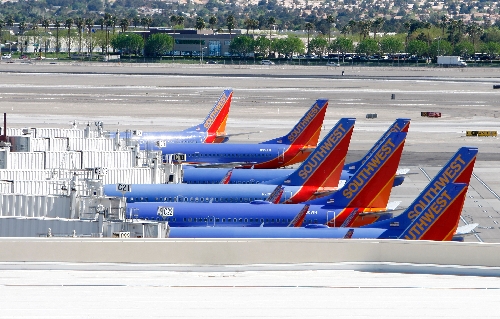Boeing engineer surprised by cracking in aircraft
A senior Boeing engineer said Tuesday the company was surprised by the rupture of the roof of a Southwest Airlines Co. jet because Boeing didn't expect cracking in the aluminum skin of such planes for many more years.
The engineer, Paul Richter, said that metal fatigue that led to the hole in the plane's roof had nothing to do with Southwest's heavy use of its planes.
Boeing 737-300 jets flown by Southwest, the type of plane that suffered a small rupture in its fuselage on Friday, make frequent appearances at McCarran International Airport.
According to the tracking service flightstats.com, one-fifth of the Southwest flights out of Las Vegas on Tuesday were the 300 series. However, not all of the 300s were included in the Federal Aviation Administration's emergency directive that required stepped-up fuselage inspections due to different designs used within the model.
In addition, the FAA directive covered some 737-500s, another series flown by Southwest, but none of its 500s were included.
How many of a particular 737 series come to Las Vegas each day fluctuates.
"We have a variable schedule that would bring an ever-changing combination of -300, -500 and -700 aircraft through Vegas on any given day," Southwest spokesman Brad Hawkins said.
Because the majority of its planes have 137 seats, with some at 122, Southwest does not follow the industry practice of trying to match widely varying plane sizes to demand on particular routes.
However, flightstats.com showed that the Southwest 300s fly to destinations in California or nearby cities in the West, such as Phoenix and Salt Lake City. According to a specification chart compiled by airline pilot Chris Brady, who has authored a 737 technical guide, the 300s have shorter ranges and higher fuel consumption than later models, limiting their value on long-distance flights.
Southwest has finished inspection of all 79 300s that were covered by the FAA order, finding subsurface cracks in five planes. The company's maintenance crews used electromagnetic devices to detect the flaws, much the way doctors use X-rays to find broken bones. The flawed planes will remain on the ground until Boeing devises a repair procedure, Southwest said.
Only two flights out of McCarran were canceled on Tuesday. According to airport records, Southwest averaged 219 flights a day in March.
Richter, Boeing's chief project engineer for models that are no longer in production, told reporters that Southwest was not at fault.
"I think it's just a statistical event ... far more than it has anything to do with Southwest and how they operate the airplane," Richter said.
The Associated Press contributed to this report.

















